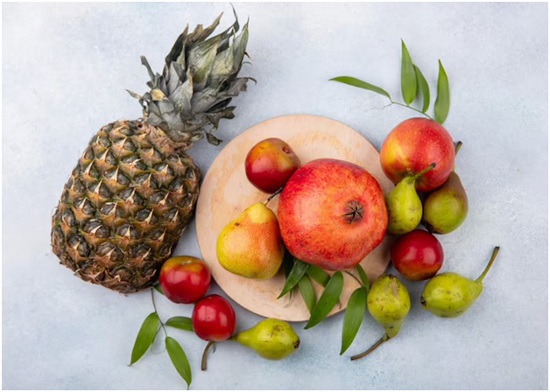If you love fruit, Thailand is where you’ll find several of the world’s greatest varieties. In fact, Thailand has so many scrumptious tropical fruits to sample that it is worth the cost of the airfare on its own.

As they are either difficult to ship or expensive to import, the bulk of Thailand’s most well-known fruits never reaches the West.
Here are 11 Thai fruits you’ve got to try. These are the best Thai fruits you’ll come across if you search for Thai fruit online.
1) Dragonfruit
The cactus family, which includes dragonfruit, is known as pitaya in Thailand. This peculiar-looking fruit has wing-like branches coming off the top and sides and is bright pink on the exterior.
The edible fruit’s interior is either white or purple, and it is filled with numerous tiny seeds that are somewhat bigger than poppy seeds.
Another uncommon variation has a yellow surface and white inside flesh. Regardless of its color, the dragon fruit is less well-known than fruits like mango and pineapple since it has a relatively mild flavor and isn’t extremely sweet.
2) Mangosteen
Thailand’s official national fruit is the Thai mangosteen, a distinctive purple fruit with a white core. Mangosteens are considered the queen of fruits since they are both gorgeous and tasty.
We can only confirm that mangosteens are high in antioxidants, despite the fruit’s numerous health claims, which include things like promoting weight loss and assisting with cooling down.
A potential drawback of this delectable fruit is that its skin is infamous for leaving stains on clothing and in some people, it may hinder blood from clotting.
3) Durian
This unique delicacy, known as the “King of Fruits,” has split opinions among those who have tasted it.
The fruit’s edible lobes are enclosed within the oblong, spiky skin. The fruit’s odor is a mix of decaying green onions and seeping sewage. If you can get beyond the odd smells, you’ll enjoy the creamy texture and sweet onion taste of this fruit.
4) Rambutan
The name of this strange fruit comes from the Malay word “rambut,” which means hair and originates in modern-day Malaysia.
The rambutan’s thin peel, which is coated in soft red and green spines that may be peeled away to expose a white fleshy inside that encloses a seed, makes up the fruit’s exterior.
While less aromatic and sweet than lychee and longan, the interior fruit is identical to those two. Make sure not to consume the peel since it is quite toxic.
5) Rose apple
Despite what its name suggests, this Thai fruit is neither an apple nor a rose. While less fibrous than an apple and not as sensitive as a watermelon, the delicate flesh is pleasant and crunchy.
The Thai apple has a flavor similar to fresh sweet pepper and flowery scents resembling its namesake rose. It is also quite juicy.
6) Jackfruit
The enormous jackfruit, which emerges from the trunk and base of the tree, may grow to a maximum length of 3 feet and a maximum weight of 50 pounds.
While less spiky than durian, the surface is comparable. The fleshy covers on the jackfruit’s edible parts contain the fruit’s seeds. The term “meat fruit” refers to the texture, which is stringy and resembles that of cooked chicken.
In savory dishes, jackfruit frequently replaces beef. As it ages, both the fragrances and the tropical flavor become stronger and more overpowering.
7) Mango
The most well-known fruit in Thailand is the mango. This sweet and occasionally sour fruit has a broad variety of culinary uses and is a staple in both savory and sweet dishes.
There are more than 200 distinct varieties of mangoes farmed in Thailand, however the Nam Dok Mai, Ok Rhong Damnoen, and Kiew Savoey green mango are the four most common forms.
The seed within the teardrop form is lengthy and rather flat, therefore it should be thrown away. When ripe, the fruit’s flesh is soft, flavorful, and fragrant; when unripe, it is sour with a chewy texture.
8) Longan
The longan fruit is related to lychee and rambutan, as well as other members of the soapberry family.
The flavor of this fruit, which is somewhat melon-like with musky overtones, sets it apart from other fruits. This is also the least appealing of the three due to its tan skin tone and tiny light brown dot patterns. The inside fruit contains a hard seed that is also packed with antioxidants.
9) Custard Apple
This exotic fruit with rough skin is revered in Thailand for having the texture that gives it its name—a custard-like consistency that may be obtained by halves of the fruit.
Eating soft, spongy meat requires some effort because many of the seeds are poisonous and must be avoided. The skin is a light green hue on the outside, but a red variant is also available and is growing in popularity.
10) Guava
This versatile fruit, which originated in Central and South America, is now cultivated all over the world in tropical regions, including Thailand.
The fruit was given the name farang since the Portuguese introduced it to Thailand; farang is also slang for westerners. The ripe and unripe varieties of this fruit’s flesh are praised for bringing out the smells of the guavas.
11) Passion Fruit
While it is not a native fruit to Thailand, people have embraced it because of the way the sweet and sour flavors are just right.
The coveted portion of this fruit is its jelly-like inside, which has a lemony scent and may be utilized to make enjoyable drinks.
Thai fruit stores sell passion fruit in three hues: purple, yellow, and green.
The seeds are edible and have a pleasant crisp feel, however, they may be a little annoying to chew, especially when eaten raw directly out of the fruit.
Since people love these fruits they often buy Thai fruit online because now they can taste these within the comfort of their homes.
